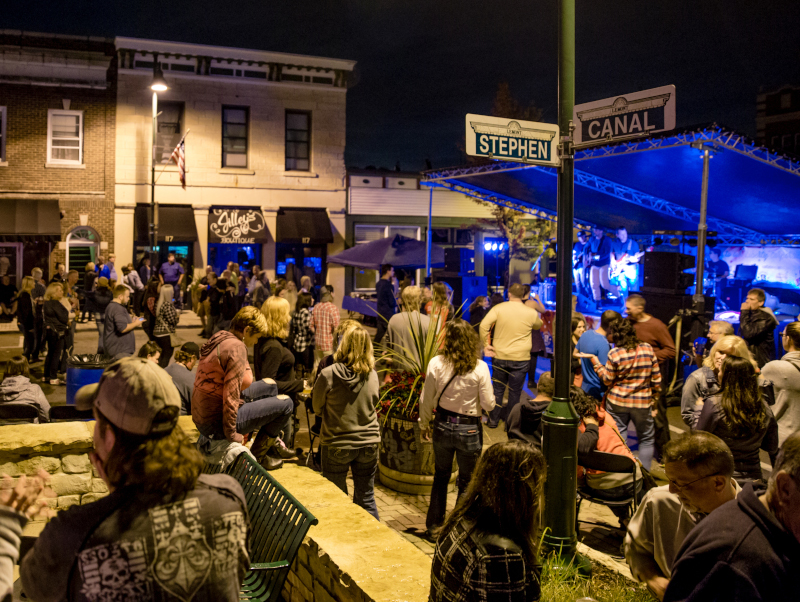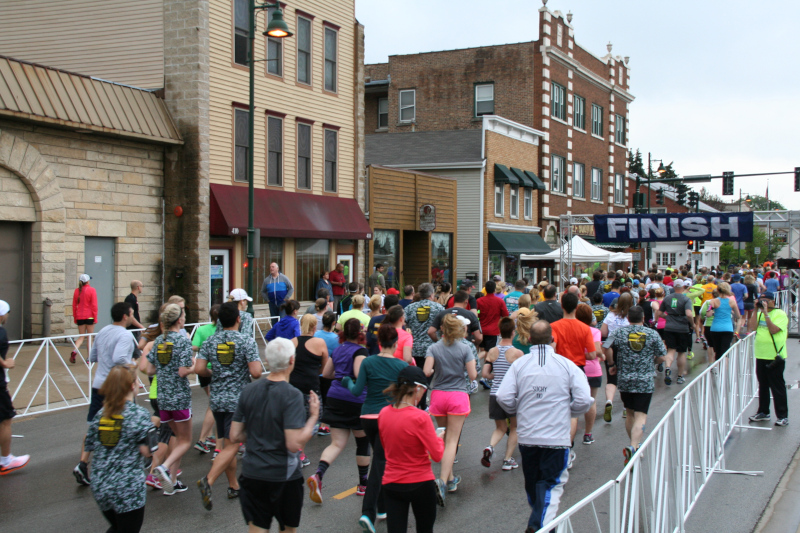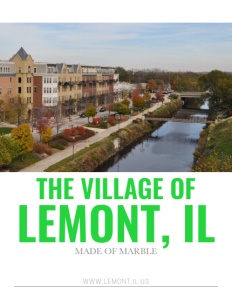The Village of Lemont, Illinois
Made of marble
Business View Magazine interviews representatives from the Village of Lemont, Illinois, as part of our focus on best practices of American towns and cities.
The Village of Lemont, Illinois, a suburb located some 28 miles southwest of Chicago in Cook, DuPage, and Will Counties, is one of the oldest American communities in northeastern Illinois. Lemont’s first settlers arrived in 1833, when the town, then called Athens, began its development along the site of the Illinois & Michigan (I&M) Canal. The canal, begun in 1836 and completed in 1848, provided a continuous waterway stretching from New York, via the Erie Canal, Lake Erie, Lake Huron, and Lake Michigan, to Chicago, then through the I&M Canal for 97 miles, entering the Illinois River at LaSalle, Illinois, to the Mississippi River, to New Orleans, and finally to the Gulf of Mexico. Almost all the early town pioneers came to work on the canal, either as contract holders or laborers. The contractors were mostly from New England or the Ohio border towns; the unskilled laborers were the newly immigrated Irish, German, Scandinavians, and French and English Canadians.
The canal workers settled along the corridor of the canal, and the farms and communities that sprang up nearby helped transform the northern region of the state from a sparsely settled frontier to a commercial, agricultural, and industrial region that supplied Chicago and areas beyond with commodities. By 1848, the town’s population had reached 3,000 people; by 1850, it had changed its name from Athens to Palymra, and finally, to Lemont.
In digging the I&M Canal, workers discovered Lemont (French for “the mountain”) yellow dolomite, a harder and finer grained version of limestone, and the quarrying industry soon became the main economic factor of the town’s growth. During the period from about 1850 to 1900 this stone, known as Joliet-Lemont limestone, and locally as Athens Marble, became one of the chief building materials used in many landmark buildings both locally and in the surrounding area. Today, 38 buildings constructed of Lemont limestone remain in the Village’s downtown district. The Chicago Water Tower, the gate to the Stockyards, Holy Name Cathedral, part of the Auditorium Building in Chicago, Old Main at Northwestern University, and part of the Capitol building at Springfield are some of the other structures constructed of Lemont limestone.
The quarry industry, like the canal before, attracted more immigrant groups, mainly from southern and south central Europe: Poland, Bohemia, Czechoslovakia, Austria, and Italy. In the second half of the 19th century, two rail lines – the Chicago & Alton, and the Santa Fe – began to replace the canal as the main mode of transportation for goods and people. The Village of Lemont, Illinois was incorporated in 1873, and by this time, it had become an important cattle, grain, and dairy shipping point. In the 1890s, construction began on the wider and deeper Chicago Sanitary & Ship Canal, built parallel to the I&M Canal, and capable of carrying waste away from Chicago, as well as more modern barges. All use of the I&M Canal ended in 1933, with the opening of the canal’s modern successor, the Illinois Waterway, of which the Sanitary and Ship Canal is a part.
The 20th century brought industrialization to Lemont, Illinois with the growth of steel, chemical, and oil companies, as well as newer, high-tech complexes, including the Argonne National Laboratory, a science and engineering research facility operated by the University of Chicago for the United States Department of Energy, and employing some 5,000 people. On the edge of town is a CITGO Petroleum refinery, and along the Sanitary & Ship Canal, there are several manufacturing firms, such as the Ozinga Ready Mix Concrete Company.
By the early 1900s, Lemont, Illinois’s quarries declined as styles changed and builders began to use Bedford limestone from Indiana and less expensive materials like concrete. Over time, the quarries filled up with water and, along with the unused I&M Canal and its adjacent trails and paths, as well as the Des Plaines River, which runs through the Village, the area, which was christened the Heritage Quarries Recreation Area, became a recreation destination with fishing, boating, hiking, and biking opportunities that has attracted, and continues to attract, both residents and visitors, alike.

Heritage Fest
“So that’s been a wonderful amenity that Lemonters have enjoyed for decades,” says Jason Berry, Lemont’s Economic Development Director. “People love to come out to Lemont, Illinois to recreate, and we’re a great weekend destination. We get kayakers coming out to the Des Plaines River; we have our Du Page County Forest Preserve and Cook County Forest Preserve to our north and to our east, and Will County Forest Preserve to the west has a trail system, as well. From downtown Lemont you can hop on your bike and you have 260 miles of trails to play on.” Mayor John Egofske agrees. “We have these natural assets so outdoor recreation is at the top of the list,” he notes. “We really want to focus on what makes us distinctive and what separates Lemont from the rest of Chicagoland,” says Berry.
An upcoming project that will further capitalize on Lemont’s recreational opportunities is the new Forge at Lemont Quarries Adventure Park, set to open in 2020. The Forge will encompass nearly 300 acres of mostly vacant land and natural areas adjacent to the I&M Canal and comprising several abandoned quarry sites. A public-private partnership between Lemont Village, Lemont Township, and The Forge Group, the new park will have the largest ropes course in Illinois, Wisconsin, Michigan or Indiana. There will also be cross-quarry ziplines, mountain biking trails, trails for running and hiking, water sports, and more.
“We’re really excited,” says Berry. “It’s a $10 million project for Phase 1, and Phase 2 can be up to $35 million. The owners have their headquarters in downtown Lemont, Illinois, and they’re working with some of the best architects and landscape architects in Chicago. They expect 250,000 visitors in year one. So, we’ve been hard at work trying to make sure that our business community and residents are ready for this incredible jolt of visitors into the downtown. We’re really lucky to have it.”
Regarding downtown Lemont, Berry notes that the area, which is on the National Register of Historic Places is “really the heart of Lemont” with many old and wonderful buildings made of Lemont limestone. “It’s a real gem,” he declares. “When the canal workers started building the I&M Canal, they started building buildings next to it to help with the commerce. So, along those same quarries, we have a dozen or more all-limestone buildings, as old as the 1840s. There was a second wave of development with the construction of the Sanitary & Ship Canal. That brought more development to downtown, which is beautifully situated in the Des Plaines River valley. North of downtown are forest preserves and as you come down the valley bluff, you see downtown Lemont, Illinois along the canals and the river, and then, housing and churches go up the south side of the bluff. So, it’s a really pretty sight.”

Quarryman Challenge
According to Egofske, downtown Lemont, Illinois has also experienced somewhat of a renaissance over the past few years. “Several buildings were vacant,” he reports, “but they’re pretty much all full, right now. We’re also getting a high-end luxury development that just broke ground in downtown. That’s about a $25-30 million investment for about 80 luxury apartments. Having a destination, such as the Forge, is huge, and as the Forge continues to develop, we have other businesses going in.” Over the past few years, several new restaurants have opened up; a hometown grocery that first opened in the 1940s has been repurposed into a Pete’s Fresh Market; and an old bowling alley that was closed for seven years, reopened a year ago.
Berry says that part of the city’s economic plan is to bring more residents to downtown in order to continue to support Lemont’s ongoing business growth. The Village is on Metra’s Heritage Corridor Line, the regional commuter rail line out of Chicago, so supporting Transit Oriented Development (TOD) is key. “It’s been a boon in the Chicago suburbs over the last two years,” he explains. “Some of our neighboring communities have seen a lot of apartment growth in their station areas, and Lemont has been planning for TODs since 2002; there’s a 2004 plan, and a 2015 plan. In the last two years, we’ve picked up these plans and started running with them. We’ve met with multi-family developers, contacting our neighbors to find out who’s developing in their communities, having them come in and sit down with us. So, we try to be proactive – not wait for the opportunity to come to us, but to go out and find it. A local developer, Rob Abbinante of Addison Properties Development and Management LLC, is doing a really special, adaptive reuse of an historic Catholic school building, St. James Academy. This is a building that was threatened with demolition and he came in and saved it. It’s a Lemont limestone building and he’s converting that to nine apartments. The same group took on the challenge of TOD housing for Lemont. It’s going to help support our downtown businesses, to help make sure that they can survive seven days a week.”
Another part of Lemont, Illinois’s economic plan concerns the use of TIFs – Tax Increment Finance Districts. “In the ‘90s and 2000s, we had a couple of TIFs in place as an incentive tool,” says Village Administrator, George Schafer. “They were used, primarily, to bring our infrastructure up to snuff – a lot of new water mains, sewer mains, and storm sewers – underground utilities. Now we’re at a point where we’re utilizing TIFs for vertical development.”
“We have several TIFs,” adds Egofske. “There’s the TOD, another one that we just implemented downtown, and they’ve been an incredible tool to drive continued and new economic growth. And it’s just not in the downtown; we’re using it in the northeast part of town, as well. We have two TIFs located out there in what was considered a highly industrial area 40 or 50 years ago. We’ve been able to rejuvenate that land and it’s going to be turned into commercial and light industrial.” In addition, Lemont’s residents recently approved a one percent sales tax to help support infrastructure improvements and road construction throughout the Village.
Today, Lemont, Illinois’s population hovers around 17,000, and according to Berry, it has been growing mostly through single-family, residential construction. “We have about a hundred new homes a year, and we have around 300 homes entitled, so we always make sure we have a pipeline of development ready to go. We have some fantastic local builders, and some national builders, as well. A couple of years back, Chicago Magazine described Lemont as ‘a mecca for Millennials.’ We see a lot of folks, who have grown up in the area, head to Chicago’s hip neighborhoods, and then, once they start to have kids, they come back to Lemont. We have two blue-ribbon schools in town: St. Cyril’s & Methodius, and Lemont High School. So we are high on the list for young parents; they see the schools, the incredible park district, and our fantastic library. It’s a very family-friendly place and we have a lot of first-time homebuyers and a lot of people that stick around, as well. We’re also seeing a lot of duplex development, right now; they’re aiming at that 55-and-up market, for the most part. So, we’ll continue to see housing development and growth over the next few years.”
“Over the years, Lemont, Illinois has always been a great place to raise a family,” Schafer says, in conclusion. “Lemont residents enjoy the ideal balance between big city amenities and small town charm. They embrace their heritage and welcome innovation. There are many one-of-a-kind family restaurants ready to serve any palate, unique shops nestled within late 19th century buildings, and murals and works of art scattered throughout the downtown. Locals enjoy mingling with visitors in our mix of taverns, pubs, and brewery to share what makes Lemont so special. Amenities such as state-of-the-art recreational facilities and programs, top-performing schools, a premier golf course, numerous festivals and events, and excellent outdoor recreation activities offer something for everyone. We continue to leverage these strategic advantages to recruit and support small businesses and bring new residents and visitors to town. We’re a very safe community and we have access to transportation – the rail line and several interstates. So, if you live here, you can work just about anywhere: Chicago, up in the northern and western suburbs, even further east. It’s a great place to live.”
AT A GLANCE
WHO: The Village of Lemont, Illinois
WHAT: A village of 17,000
WHERE: 28 miles southwest of Chicago in Cook, DuPage, and Will Counties
WEBSITE: www.lemont.il.us
PREFERRED VENDORS
Lemont Quarries Adventure Park – hello@theforgeparks.com | 630-326-3301
Nestled on the banks of the famous Illinois and Michigan Canal, Lemont’s old quarries hold historical significance for both the town and the greater Chicagoland area alike. As a key driver of economic development in the mid-1800s, the quarries and the dolomite limestone they produced, cemented Lemont’s place in history. Fast-forward to 2020, and the quarries are beginning to play a momentous role in raising the profile of the town again thanks to the launch of The Forge: Lemont Quarries Adventure Park.
Lemont Quarries Adventure Park is an innovative public/private partnership designed to exhilarate, educate, and entertain adventurers of all ages and abilities through outdoor recreation. Regardless of their ability or experience, everyone age 3 to 93 is sure to find activities that will get their heart racing, fill them with energy, and put a smile on their face.
Lemont Quarries Adventure Park features the largest aerial adventure course, tallest climbing towers, and longest ziplines in the tri-state area. It also offers mountain biking, rock climbing, kayaking, canoeing, and paddleboat excursions that feed the appetite of adventure enthusiasts looking for unique challenges. There is even a designated kid’s activity zone that promises to bring to life the wildest imagination of every young adventurer.
Aside from the physical challenges, the park also provides a community-focused space that celebrates the local natural environment and enables guests to pursue personal achievement while connecting with a passionate community of outdoor enthusiasts. People seeking an authentic yet accessible experience will find serene fishing spots as well as miles of running, biking, and walking trails that are free and open to the public.
In addition to promoting an active outdoor lifestyle, the park offers opportunities for guests to engage in educational and entertaining activities through skills development programs, school field trips, environmental education programming, customizable team-building events, birthday parties, weddings, and more. Throughout the year, the park will also play host to a series of concerts, music & film festivals, and unique cultural and holiday-oriented events.
As part of its unique private/public partnership with the village and township of Lemont, Lemont Quarries Adventure Park is committed to the restoration and preservation of the historic natural landscape found at the quarries. Our team is proud to support conservation and restoration efforts in the quarries so that future generations can enjoy and engage with its vibrant natural ecosystem.



